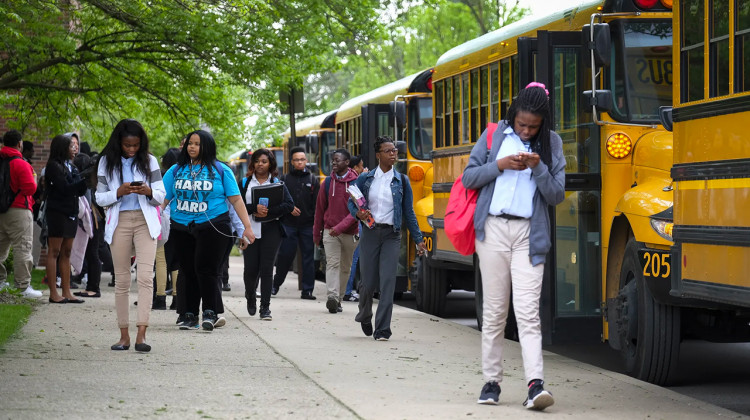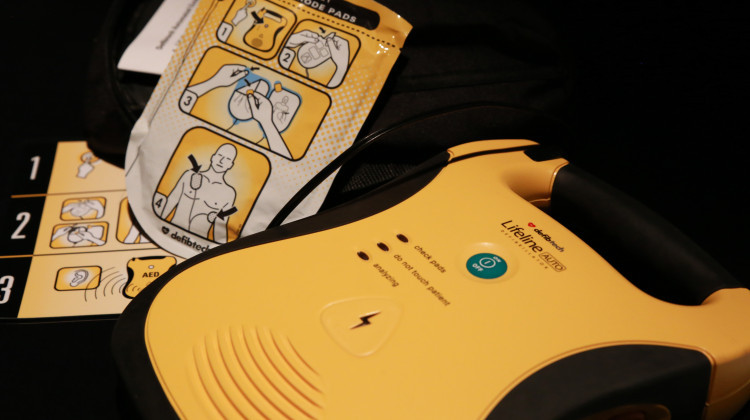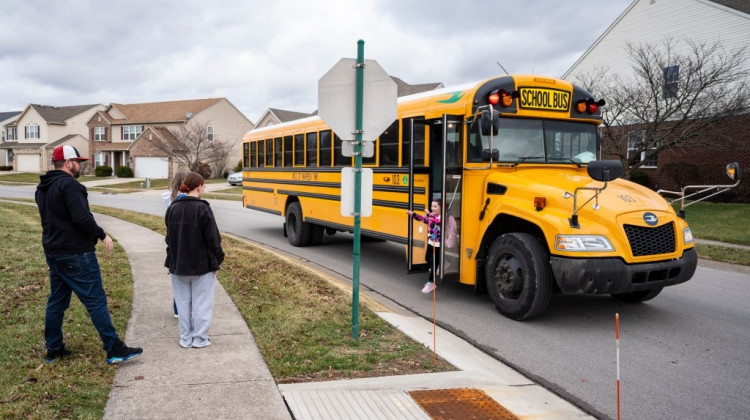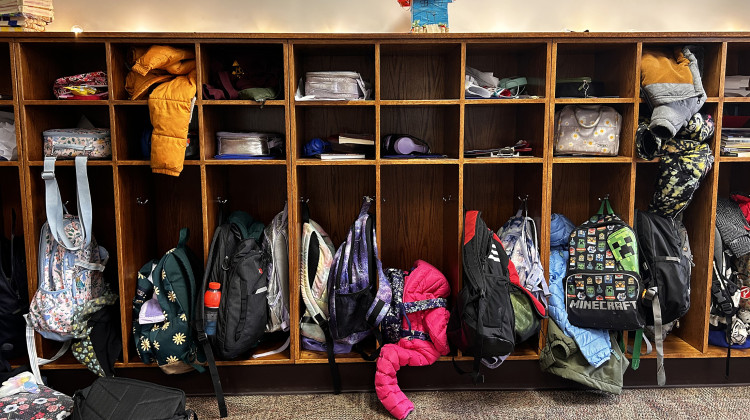
An Indiana law requiring students to be transported only in yellow school buses is too restrictive, a charter proponent says.
(Alan Petersime for Chalkbeat)When Global Preparatory Academy went searching for a way to bring students to school this year, it found that most transportation providers were too understaffed to take on another contract. But finding its own vehicle turned into a monthslong odyssey.
After purchasing a $52,000 Ford Transit and having it shipped from New York, the Indianapolis charter school learned it could not use the van because it did not meet state school transportation standards, CEO Mariama Shaheed said.
The problem? It wasn’t a yellow school bus.
It’s a state law that The Mind Trust, an Indianapolis-based charter advocacy group, hopes the legislature will change next year, highlighting in a new report how the requirement creates a costly burden for charter schools in particular.
Scrambling, Global Prep staff began to call car-riding families, offering to pay mileage if they could transport kids who lived near them to school.
“We felt like we had to take matters into our own hands,” Shaheed said. “I realized transportation is a much bigger issue than just getting a bus.”
The report recommends legislation that would allow schools to use other vehicles that are easier and less costly to operate. It argues that, along with sharing routes and operations among schools, raising driver pay, and offering families a stipend to opt out of bus service, the change would help improve school transportation.
“The right school for you might be really far away, and if we’re only using yellow buses, you might have to spend more than an hour each way,” said Kristin Grimmie, senior vice president of strategy at The Mind Trust. “We don’t believe that’s the best or most modern way to get kids to the school of their choice.”
The Mind Trust’s report asserts that Indiana schools have long struggled with transportation woes — recently made worse by COVID-19 — but that charter schools especially have less leverage to negotiate transportation contracts. While traditional districts have historically provided busing, charter schools don’t receive the local property tax funding that pays for transportation.
They may also serve students from a broader geographic area, and stand to lose enrollment when transportation isn’t available.
Because Global Prep falls under the IPS umbrella, the district provides transportation for students who live within IPS boundaries. But 10% of students live outside those boundaries, and need transportation.
The school eventually purchased a $39,000 14-passenger school bus, with the intent to provide transportation in December — and projected to save money over its previous $60,000 contract with Durham School Services. But those plans were delayed when staff discovered that one of the new bus’s windows had been broken.
Why schools use yellow buses
The primary purpose of extensive laws governing school buses is safety. The buses are required to have features that protect students on board, like rollover protection, flashing lights, and stop-arm signs. Even the color — National School Bus Glossy Yellow — is considered to be highly visible to other motorists, who face steep penalties for not stopping for a bus.
According to the National Highway Traffic Safety Administration, children are 70 times safer in a school bus than a car when traveling to and from school.
Patrick McManamon, president of the National Association of State Directors of Pupil Transportation Services, said the organization believes the safest form of school-related transportation is a yellow bus.
“NASDPTS recognizes that school districts are faced with transportation challenges which drive some of the hard decisions they must make,” McManamon wrote in an email. “As an association which makes their No. 1 priority the safe transportation of school-age children, our hope is when making those difficult decisions the district puts students safety as the top priority.”
Indiana law agrees, allowing alternative vehicles only to transport students to extracurricular activities and back, as well as for certain federally defined groups, like students with disabilities or those experiencing homelessness.
The rigidity is unusual for a state that has embraced choice and deregulation, and especially given that nearly half of all states permit alternative vehicles for school transportation.
Arizona recently offered grants to develop school transportation alternatives, including vans at one charter school. Massachusetts also allows certain kinds of vans, if all passengers and the driver are wearing seat belts.
The Mind Trust report suggests there are ways to improve safety in Indiana if schools were to use vans to transport students.
It notes that many safety features like large markings could be added to other kinds of vehicles. New recommendations by the National Transportation Safety Board suggest adding seat belts to school buses, the report says.
Report: Transportation affects school choice
The current law stymied the group’s pilot program to hire and train more drivers and centralize transportation for the five charter schools.
While the organization found 12 would-be drivers, Grimmie said its overtaxed transportation provider couldn’t provide vehicles or training and placement for the candidates. Without the flexibility to operate vans or rely on drivers without commercial licenses, the pilot never got off the ground.
“This left participating schools with no other choice than to purchase their own buses and shuttles to avoid losses in enrollment, and to narrow the scope of their transportation services, making it harder for families to access high-quality schools of their choice,” the report said.
Grimmie said that at full capacity, the pilot would have served around 400 students. The group may try again next year depending on legislative action.
Hiring and retaining drivers with commercial licenses has proved a challenge for other districts in Indiana. Notably, Pike Township has canceled in-person classes several times this year due to a lack of drivers and protests over their pay.
The report recommends raising bus driver wages to a minimum of $18 per hour, though some school districts have offered even more due to the driver shortage. It also recommends paid training and opportunities to work additional hours in other roles during the middle of the school day, to help make the jobs better paid and more attractive.
The report also recommends criminal background checks and periodic drug tests for anyone hired to transport children in any kind of vehicle.
For families, the report also recommends offering opt-out subsidies for those who live far from school or in underpopulated areas in order to reduce transit times and costs to the school district. That money could be used to defray parents’ gas costs, or fund bus passes and ride shares, Grimmie said.
Last school year, transportation challenges ate into enrollment at Rooted School, a charter school on Indianapolis’ eastside. Two bus companies canceled contracts in a matter of weeks, which led to families leaving the school, said Rooted School Executive Director Ma’at Lands at a Mind Trust event last week announcing the report and its recommendations.
“For many students, the promise of choice can be an empty one if they cannot physically access the school via transportation by their parents or the school,” Lands said.
Chalkbeat is a nonprofit news site covering educational change in public schools.
 DONATE
DONATE






 Support WFYI. We can't do it without you.
Support WFYI. We can't do it without you.